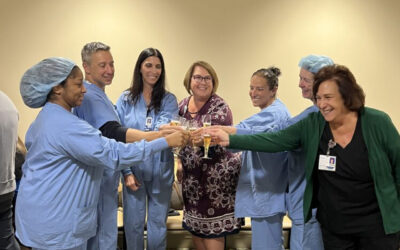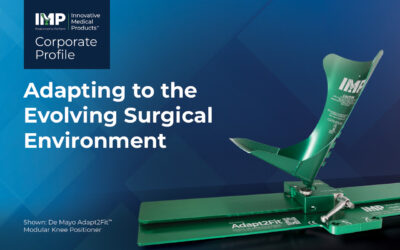Sponsored by Medline
 What happens to HAIs when best practices are used? They decrease. Medline’s priority is patient safety and this starts with protecting patients against leading hospital-acquired infections (HAIs). Many of these infections, like surgical site infections (SSIs) and hospital-acquired pneumonia (HAP), can be prevented by implementing a comprehensive solution that is both compliance-driven and intuitive to use in every day clinical practices. These practices include preparing the skin, the nares and oral cavity to reduce the risk of bacteria that can lead to extended length of stay, increased costs and increased morbidity rates.
What happens to HAIs when best practices are used? They decrease. Medline’s priority is patient safety and this starts with protecting patients against leading hospital-acquired infections (HAIs). Many of these infections, like surgical site infections (SSIs) and hospital-acquired pneumonia (HAP), can be prevented by implementing a comprehensive solution that is both compliance-driven and intuitive to use in every day clinical practices. These practices include preparing the skin, the nares and oral cavity to reduce the risk of bacteria that can lead to extended length of stay, increased costs and increased morbidity rates.
Medline understands the importance of incorporating pre-surgical decolonization practices in everyday care and has solutions to help fight against deathly hospital-acquired infections.
Pre-surgical Skin Preparation
SSIs occur in 2% to 4% of all patients undergoing inpatient surgical procedures.[1] While advances have been made in infection control practices, SSIs remain a substantial cause of morbidity, prolonged hospitalization, readmissions and death.[2]
One technique to reduce the likelihood of an SSI is to prep the incision site prior to surgery with an antiseptic in order to reduce the microbial burden on the skin. The goal of preoperative patient skin antisepsis is to reduce the patient’s risk of developing an SSI by removing soil and transient microorganisms at the surgical site.[1]
Given the wide array of microbial species that can cause an infection, particularly Staphylococcus aureus, coupled with the prevalence of antibiotic resistant pathogens, an antiseptic with broad spectrum antimicrobial activity has the characteristics to be an effective preoperative skin preparation product.
An effective skin preoperative antiseptic as described by the U.S. FDA document, “Final Rule for Safety and Effectiveness of Health Care Antiseptics,” is an agent that rapidly reduces the number of organisms in the surgical field before wound incision and suppresses rebound growth for six hours after application[3].
Chlorhexidine gluconate (CHG) is a broad-spectrum antiseptic with a proven safety record. CHG may have advantages over povidone-iodine, including the fact that increased amount of CHG on the skin leads to enhanced activity, longer residual activity and activity in the presence of blood or serum.[4]

Nasal Decolonization
In addition to pre-surgical skin preparation, nasal decolonization is proven to be an effective adjunct strategy to assist the medical industry in warding off SSIs and HAP. Multiple studies have demonstrated that eradication of S. aureus nasal colonization results in decreased infections, specifically for those patients undergoing surgery or receiving care in intensive care units.[5] The normal flora residing in the nose is wide-ranging such as Staphylococcus aureus, Streptococcus pneumonia and Haemophilus influenza.[6] The risk of S. aureus SSI in nasal carriers has been found to be 5.8x greater than in non-nasal carriers.[7]
Antiseptic agents such as Medline’s 62% alcohol nasal swabs, will effectively kill potentially dangerous pathogens such as S. aureus within 10 minutes of the first application. Ethyl Alcohol 60-90% is effective against pathogens because it denatures proteins.[8] Povidone iodine 10% has broad-spectrum antimicrobial activity against gram-positive, gram-negative bacteria, and fungi if used 1 hour before surgery. The risk of developing resistance to either antiseptic agent is highly unlikely and may contribute to antibiotic stewardship.9 The science behind the practice of nasal decolonization is practical, cost-effective and gives patients one more effective line of defense against SSIs and HAIs.
Oral Decolonization
Hospital-acquired pneumonia (HAP) and ventilator-associated pneumonia (VAP) continue to be described as significant causes of illness and death in health care “despite improvements in prevention, antimicrobial therapy, and supportive care”.[10] Pneumonia is one of the most common types of HAIs.
Multiple health care guidelines include recommendations for the use of oral antiseptics like chlorhexidine gluconate (CHG), 0.12%, and cetylpyridinium chloride (CPC) to reduce risk of hospital-acquired pneumonia and ventilator-associated pneumonia.[12,13,14] Oral decolonization with CHG can be considered an important tool in infection prevention and control.[15]
Good health starts with oral health. Reduce the risk of HAP by providing a comprehensive oral care program for every type of patient care – preoperatively and postoperatively.
Medline’s Total Prep System Preoperative Kit
For a one-stop-shop preoperative decolonization solution, Medline has your patient covered with the Total Prep System Preoperative Kit.
- Prepare the SKIN with ReadyPrep 2% CHG Cloth
- Decolonize the NOSE with 10% Povidone-Iodine Nasal Swabs or 62% Ethyl Alcohol Nasal Swab options
- Decolonize the MOUTH with 0.12% CHG Oral Rinse or DuoCare Clinical Oral Rinse (0.1% CPC)
Infection prevention is more necessary than ever and the need for proactive pre-surgical decolonization practices is critical. Let Medline provide decolonization solutions for a safer tomorrow.
For more information, visit www.medline.com/pages/pre-operative-prep-system.
References
- https://psnet.ahrq.gov/primer/surgical-site-infections
- Awad, S.S., “Adherence to surgical care improvement project measures and postoperative surgical site infections”. Surgical Infection (Larchmt), 13(4): (2012): 234-7 https://www.cdc.gov/nhsn/pdfs/pscmanual/9pscssicurrent.pdf
- https://www.fda.gov/media/135559/download
- Anderson D.J. et al. (2014). Strategies to Prevent Surgical Site Infections in Acute Care Hospitals: 2014 Update. Healthcare Infection Control Practices Advisory Committee. The Centers for Disease Control and Prevention guideline for the prevention of surgical site infection, 2017. JAMA Surg published online May 2017. doi:10.1001/jamasurg.2017.0904
- Sievert DM, et al. ICHE 2013;34:1-14 . ICHE 2013;34:1-14
- https://www.atsjournals.org/doi/full/10.1513/pats.201006-038rn
- Skrämm I, et al. . Surgical site infections in orthopaedic surgery demonstrate clones similar to those in orthopaedic S. aureus nasal carriers. J Bone Joint Surg Am. 2014. 96(11):882-88
- https://cmr.asm.org/content/29/2/201#sec-2 Septimus EJ, Schweizer ML Decolonization in Prevention of Health Care-Associated Infections. Clinical Microbiology Reviews Jan 2016, 29 (2) 201-222; DOI: 10.1128/CMR.00049-15
- T. Poovelikunnel, G. Gethin, H. Humphreys, Mupirocin resistance: clinical implications and potential alternatives for the eradication of MRSA Journal of Antimicrobial Chemotherapy, Volume 70, Issue 10, October 2015, Pages 2681–2692, https://doi.org/10.1093/jac/dkv169 Published: 03 July 2015
- Klompas, M. (2020, July 6). Epidemiology, pathogenesis, microbiology, and diagnosis of hospital-acquired and ventilator-associated pneumonia in adults. UpToDate. https://www.uptodate.com/contents/epidemiology-pathogenesis-microbiology-and-diagnosis-of-hospital-acquired-and-ventilator-associated-pneumonia-in-adults#H1 Accessed July 30, 2021.
- Magill SS, Edwards JR, Bamberg W, Beldavs ZG, Dumyati G, Kainer MA, Lynfield R, Maloney M, McAllister-Hollod L, Nadle J, Ray SM, Thompson DL, Wilson LE, Fridkin SK; Emerging Infections Program Healthcare-Associated Infections and Antimicrobial Use Prevalence Survey Team. Multistate point-prevalence survey of health care-associated infections. N Engl J Med. 2014 Mar 27;370(13):1198-208. doi: 10.1056/NEJMoa1306801 Accessed July 30, 2021.
- Tablan OC, Anderson LJ, Besser R, Bridges C, Hajjeh R. Guidelines for Preventing Health-Care Associated Pneumonia, 2003. Centers for Disease Control and Prevention. https://www.cdc.gov/mmwr/preview/mmwrhtml/rr5303a1.htm Published March 26, 2004. Accessed July 30, 2021.
- Vollman K, Sole ML, Quinn B. Procedure 4 – Endotracheal Tube Care and Oral Care Practices for Ventilated and Non-ventilated Patients. In: AACN Procedure Manual for High Acuity, Progressive, and Critical Care. 7thEdition. Vol 37. 2nd ed. ELSEVIER.
- Greene LR, Sposato K. Guide to the Elimination of Ventilator-Associated Pneumonia. Association for Professionals in Infection Control and Epidemiology. 2009:1-47. Page 36. http://dl.icdst.org/pdfs/files3/b25692879bf1679e1c52f38ca431b94c.pdf. Accessed July 30, 2021.
- Weinstein RA, Milstone AM, Passaretti CL, Perl, TM. Chlorhexidne: Expanding the Armamentarium for Infection Control and Prevention, Clinical Infectious Diseases, 46(2): 15 Jan 2008, pp274-281. https://doi.org/10.1086/524736 Accessed August 8, 2021.




![[Sponsored] Company Showcase: Medline](https://ortoday.com/wp-content/uploads/2021/09/medline-1080x675.jpg)





